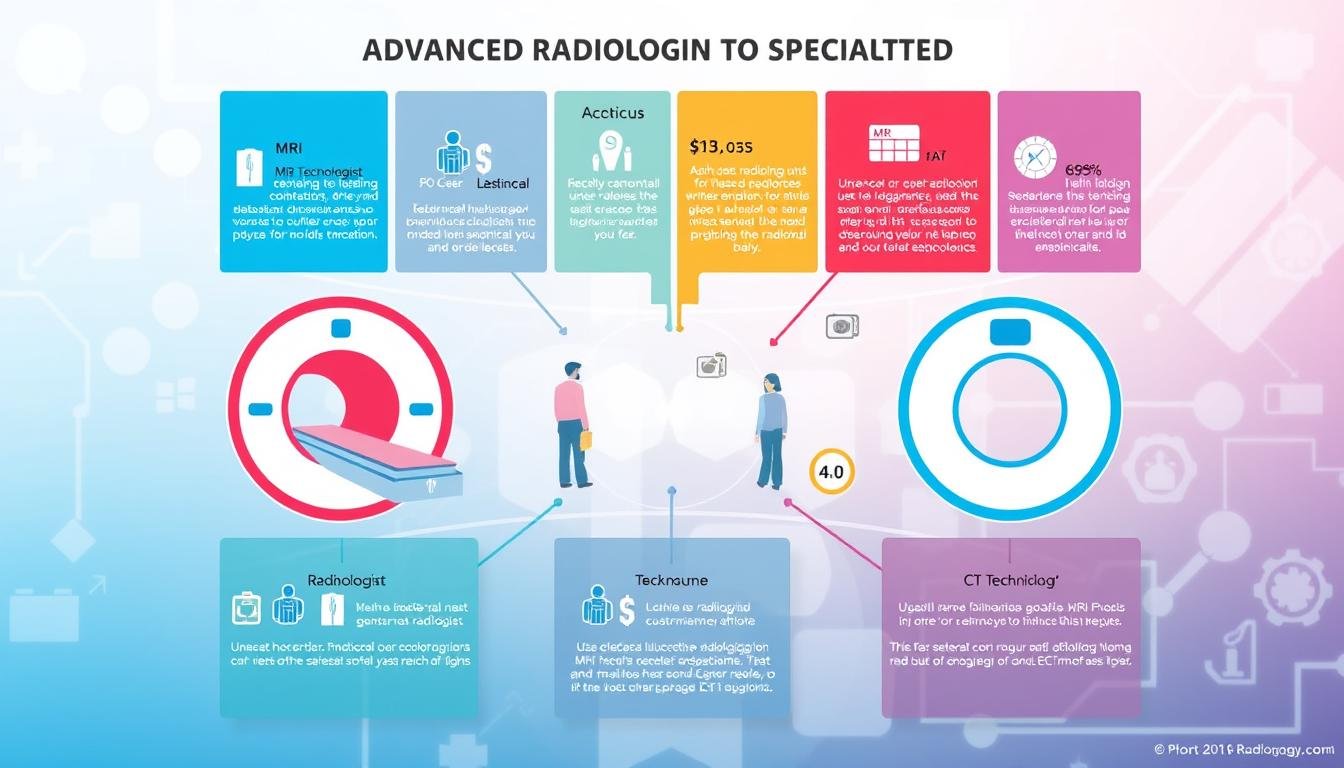Radiology technicians earn competitive salaries in the medical imaging field. This guide explores earnings, factors, and growth opportunities for radiology techs in the US.
A radiology technician working in a modern hospital setting, surrounded by advanced imaging equipment like MRI and CT scanners, with a backdrop of a busy medical environment, displays professionalism and focus. Visual elements symbolizing salary figures, such as dollar signs or financial charts, are subtly integrated into the scene.
Radiology techs operate specialized medical imaging equipment. They capture detailed body images for physicians to diagnose and treat conditions.
These professionals use X-ray machines, CT scanners, and MRI machines. As technology advances, the demand for skilled radiology technicians remains high.
Understanding Radiology Tech Salaries
Radiology technologists play a crucial role in healthcare. They operate equipment to capture medical images for accurate diagnoses.
Salaries for radiology techs vary based on several factors. Education and certification are primary determinants of their pay.
Entry-level jobs usually require an associate’s degree in radiologic technology. Advanced roles may need a bachelor’s degree or specialized training.
Professional certifications from ARRT can boost earning potential. Geographical location also affects radiology tech salaries.
Techs in major cities often earn more than those in rural areas. This is due to higher living costs and healthcare demand.
Specialization can increase a radiology tech’s compensation. Experts in cardiovascular imaging or mammography may earn higher salaries.
Proficiency with cutting-edge equipment can boost earning potential. Leadership roles may also lead to increased pay.
National Average Salary for Radiology Techs
Radiology techs in the United States earn about $60,000 per year, which puts them among the highest-paid healthcare workers.
Their pay is often more than that of medical assistants and pharmacy technicians, and it can even surpass that of some nursing jobs.
Radiology techs make about 20% more than the overall median wage. This shows the high demand for their skills in healthcare.
Pay can change based on experience, location, and certifications. The national average shows good earning potential for radiology techs.
The need for skilled radiology professionals will likely stay strong, making radiology a stable career choice.
Entry-Level Radiology Tech Salaries
New radiology techs earn between $49,000 and $55,000 yearly. Certification, location, and speciality affect earning potential.
Certified techs earn about $5,000 more per year. This shows the value of getting certified.
Location impacts entry-level salaries. California, New York, and Massachusetts offer higher pay.
Specializing in CT, MRI, or cardiovascular imaging can boost earnings. This helps new grads earn more.
Understanding these factors helps aspiring techs make smart career choices and maximize their earnings.
Radiology Tech Salaries by State
Location plays a big role in radiologic technologist salaries. High-paying states often have higher living costs.
Salary data helps aspiring professionals choose where to work. California, Massachusetts, and Alaska offer the highest wages for radiology techs.
California leads with over $78,000 per year. However, these states have higher living costs, too.
Missouri, Indiana, and Arkansas have lower salaries. They also have lower living costs.
This means a paycheck can go further in these places. Job seekers should consider both salary and living costs.
Many factors affect radiology tech salaries. These include the local economy, healthcare demand, and living costs.
Understanding salary differences helps make better career choices. It helps find the best fit for your needs.
Advanced Positions and Specializations
Radiology technologists can unlock rewarding career paths with advanced positions. These roles offer higher earnings and specialized certifications.
Radiologic technology offers many opportunities for professional growth. The field also provides chances for financial advancement.
Specialized areas include computed tomography (CT) and magnetic resonance imaging (MRI). Mammography and interventional radiology are other options for specialization.
Each specialization requires unique skills and certifications. MRI technologists often earn more than general radiologic technologists.
This visually striking infographic-style illustration depicts various advanced radiologic specializations. It features symbolic representations of roles like MRI technologist, ultrasound technician, and CT technologist, each with distinct colour-coded sections and icons. The background is a subtle gradient blending medical imagery and technology elements, emphasizing the concept of earnings in the radiology field without any text or characters.
Radiology techs can further their career with advanced degrees. They can also pursue managerial or educational roles.
Leadership positions in radiology departments offer salary growth opportunities. Teaching in radiology technology programs can also increase earnings.
Investing in professional development unlocks advanced imaging careers. It also helps maximize the earning potential of radiology professionals.

Salary Growth Potential
Radiologic technologists can expect steady salary increases as they advance. Experienced professionals often earn much more than those just starting.
Skills and expertise gained over time drive this growth. Advanced roles with more responsibilities also lead to higher pay.
Continuing education is key to boosting a radiology tech’s earning power. Additional certifications and degrees can open doors to better-paying jobs.
Many employers offer tuition help for ongoing learning. This support helps techs develop new skills and advance their careers.
Experience and education combine to grow earnings, making radiology techs a smart choice for a stable healthcare career.
The field offers great potential for financial growth, making it an attractive option for those seeking a rewarding job.
Benefits Beyond Salary
Radiology techs enjoy many perks besides their base pay. Healthcare and retirement plans provide long-term security and peace of mind.
Many roles offer flexibility and work-life balance. These advantages can boost your overall job satisfaction.
Radiology techs often get great healthcare coverage. This includes medical, dental, and vision insurance options.
Retirement savings plans, such as 401(k) plans or pensions, are common. They help build a secure financial future.
Flexible scheduling is a major perk for many radiology techs. Part-time, evening, or weekend shifts are often available.
This flexibility helps balance work and personal life. It’s great for those with family commitments or other interests.
Radiology techs often enjoy a positive work environment. They find purpose in contributing to patient care.
Working with a dedicated healthcare team is rewarding. These benefits make radiology tech careers very appealing.
Job Demand and Industry Outlook
The radiology tech job outlook is bright. New tech in medical imaging drives demand for skilled pros.
Medical imaging services are growing fast. This fuels great career prospects in the field.
Tech impacts radiologic salaries in many ways. New tools create a need for techs with special skills.
Ongoing training is key. It helps boost pay for radiology pros.
The Bureau of Labor Statistics predicts strong job growth. Radiology tech jobs may grow 9% from 2019 to 2029.
This growth beats the average for all jobs. More old folks and chronic illnesses drive the need.
Medical imaging use is also on the rise. This ensures a bright future for radiology techs.
Recommended Resources for Aspiring Radiology Techs
Starting a radiology tech career is thrilling. Many resources can help guide you on this path.
Professional growth and industry knowledge are key. Join organizations like ASRT or ARRT for valuable support.
These groups offer education, networking, and job boards. They provide salary tips and keep you updated on field advancements.
Websites like RadiologyTechPrograms.org offer information on career paths and education, and RadiologyTechSalary.com provides details on salary trends in the field.
Industry publications like Radiology Business share insights for radiologic technologists. Applied Radiology keeps professionals updated with the latest news.
These resources can help you reach your radiology tech goals. Stay informed to boost your earning potential and career growth.
Conclusion: Making Informed Career Choices
Radiology technology is a rewarding field with many opportunities. It is crucial to make career decisions that match your goals and financial needs.
The industry provides stable careers with good salary potential. Continuous learning is key to staying ahead in this ever-changing field.
Understanding salary factors helps in making smart career choices. Keeping up with trends and new technologies is important for success.
Your radiology career is a journey of growth. Embrace learning and develop special skills to unlock new chances.
With the right attitude, you can build a fulfilling career with good pay and personal satisfaction.
FAQ
What is the average salary for a radiology tech?
The median annual salary for radiology techs is about $61,900, according to the Bureau of Labor Statistics for 2020.
What factors influence a radiology tech’s salary?
Education, experience, and certifications impact a radiology tech’s salary. Location and healthcare settings also play a role.
How much do entry-level radiology techs make?
Entry-level radiology techs usually earn between $40,000 and $55,000 yearly. Their pay depends on qualifications and location.
Which states pay the highest salaries for radiology techs?
California, Massachusetts, Alaska, Washington, and Hawaii pay the most. These states offer salaries above the national average.
Can radiology techs increase their earning potential through specialization?
Yes, specializing can boost a radiology tech’s salary. Areas like CT scanning, MRI, or mammography often pay more.
How can radiology techs advance their careers and boost their salaries?
Continuing education and getting advanced certifications can increase earning potential. Taking on leadership roles also helps boost salaries.
What benefits do radiology techs typically receive beyond their base salary?
Radiology techs often get healthcare benefits and retirement plans. They also receive paid time off and other perks.
What is the job outlook for radiology techs in the future?
The job outlook for radiology techs is bright. An ageing population is driving demand for diagnostic imaging services.
You may also read: Where is Texas Tech: Location & Campus Guide
